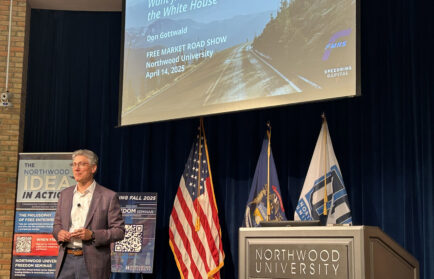By Dr. David Friedman
Editor’s note: Dr. David Friedman, an American economist and son of Nobel laureate Milton Friedman, will be the March 16 keynote speaker at the 2023 Northwood University Freedom Seminar.
All societies face the coordination problem: In order to do anything complicated, you have to somehow get millions of people to coordinate their activities. To make automobiles, you need steel. To make steel, you need iron and carbon. To make iron, you need iron ore and coal.
There are two solutions and one of them doesn’t work. The one that doesn’t work is the obvious one: centralized coordination (i.e. somebody at the top telling everyone else what to do). That might work for a very small group of people, a football team or a small firm, but it scales badly. As the number of people being coordinated increases, it becomes harder for the person at the top to figure out what everyone should do, know what everyone is doing and make them do it. More likely, the person at the top, separated by many layers from the people he is supposed to be serving, will base his decisions on his interests rather than theirs. At the scale of a country, it works catastrophically badly, as demonstrated by, among other things, the collapse of the Soviet Union.
The solution that works is the decentralized one. Everything belongs to someone. Each person decides what to do with himself and his stuff. People coordinate through the market, with prices signaling whether more or less of something should be produced. If there is not enough iron ore for the steel for the chain saws to cut down the trees to make the pencils and for everything else steel goes into, the price of iron ore goes up, giving miners an incentive to mine more, and users an incentive to use less.
In order for this to work, to successfully coordinate people, things have to somehow be set up so that it is in each individual’s interest to make the right decision for his part of the problem, the decision that takes account of its effect on everyone else. That cannot be done perfectly but a market system can do it surprisingly well. In order to produce things, I have to pay my workers enough so that working for me is at least as attractive as whatever else they could do with their time, and to pay for my inputs at least as much as they cost to produce or are worth to other people. Selling what I produce transfers the benefit of producing it back to me, so both costs and benefits go into my calculation of what to do. If benefit is greater than cost, it is in my interest to do it and in our interest for it to be done. Individual decisions add up to the right group decision. And the decentralized solution scales — up to the size of a global economy.
That is a very sketchy description of what takes a semester or two of price theory to fully explain.
The mechanism works for voluntary transactions, since you won’t sell me your labor or your goods unless I pay at least what they are worth to you. It does not work for involuntary transactions.
You are running a steel mill. To get iron ore, you have to pay someone enough to cover the cost of mining it. To turn it into steel, you have to pay workers enough so they are willing to work for you. Unfortunately, your mill also produces sulfur dioxide, making people who live downwind of you cough. Since that is a cost for them but not for you, it gets left out of your calculation of how much steel to produce, how to produce it, what price to sell it for. You might find making steel profitable even if the total cost, including the cost born by downwind neighbors, was greater than the value of the steel to your customers.
For other examples, consider a college student playing loud music when other students in the dorm want to sleep, an airplane rattling the windows of houses below the flight path as it comes in to land, someone with a cold going to a party. A sufficiently wise government might be able to fix the problem, get us back to a system where things are done if and only if they are worth doing, by appropriate regulations, but doing that is hard because it replaces the decentralized market system that scales with a centralized command system that doesn’t. Most of the time, for the minor externalities associated with many ordinary activities, it is not worth doing. For larger externalities, it might be. Or might not — knowing what should be done is not always easy.
Consider population
Sixty years ago, population growth was seen as an impending catastrophe in the view of almost everyone who mattered, and society felt drastic action was required. The Population Council, a private organization concerned with population issues, asked me to write a piece on population growth looking at the issue from the standpoint of someone generally in favor of the market system.
The issue, as I saw it, was what externalities were associated with the decision to have a child, so I tried to estimate them. My examples so far have been negative externalities, costs produced by one person’s actions that someone else has to bear, but there are also positive externalities, benefits rather than costs. If a student in the dorm room next to mine plays music I like when I am trying to fall asleep that is a positive externality — I like to fall asleep to music. Basic research in medicine produces a positive externality in the form of knowledge of how to cure diseases. When I repaint my house, I produce a positive externality for my neighbors, who get a better view out of their windows. If my action produces a negative externality, I may do it even when, considering all costs and benefits, it is not worth doing. If it produces a positive externality, I may fail to do it even when it is worth doing.
What if the same action produces both positive and negative externalities? Your child may become a criminal and impose costs on my children. He may become a novelist or musician and produce works that my children enjoy. He will probably go to a public school, imposing costs on the taxpayers who pay for it, but after he graduates, he will pay taxes for the school he is no longer going to, reducing the cost to other taxpayers. He will produce a wide variety of costs and benefits for other people.
The conventional wisdom of the time looked only at the costs and concluded that we would be better off if everyone had fewer children. I tried to look at both costs and benefits, negative and positive externalities, and add them up. If costs were much larger than benefits, as most at the time believed, we would be better off with less population growth than would result from individuals freely choosing how many children to have, if benefits were larger than costs, with more. The first implies that governments should try to hold population growth down, perhaps by subsidizing birth control or giving tax benefits to childless couples or by making it illegal for any couple to have more than one child, as China did. The second implies the opposite. And if costs and benefits were roughly equal, making the net externality close to zero, there would be no reason for governments to interfere in either direction.
I tried to list all of the externalities I could think of and make rough estimates of their size. My conclusion was that I could not sign the sum, that the estimates were too uncertain to know whether additional population was, on net, a good or bad thing.
I published my paper in 1972 and I still don’t know. What I do know is that the conventional wisdom of the time was wrong, because it claimed not only that the net externality was negative but that it was large. The book, The Population Bomb, published by Paul and Anne Ehrlich in 1968, confidently predicted unstoppable mass famine in the 1970’s, hundreds of millions of people starving to death due to overpopulation. It sold millions of copies. Not everyone agreed that things were that bad but almost everyone involved in the controversy agreed that population growth, if not greatly reduced, was going to be a major problem making poor countries poorer.
Populations of poor countries continued to grow. Ehrlich’s famine did not happen. Calories per capita in poor countries went up, not down. Extreme poverty fell sharply. That does not prove the net externality was positive — perhaps we would have been even better off with less population growth. But the effect could not have been as negative as the expert opinion of the 60s and 70s claimed since what happened was the opposite of their predictions.
Climate change raises the same question
Climate change also will have both positive and negative externalities. The question is again whether the net effect will be positive or negative and how large.
There are two approaches to answering that question. The first is to ask whether there are general reasons to expect climate change along the predicted lines, a gradual increase in average temperatures due mainly to increased CO2 in the atmosphere, to have net negative effects. The second is to look at specific externalities, make some rough estimate of their size, and add them up.
There is one a priori reason to expect net negative effects from change — that current human activity is optimized against current conditions, making change in either direction presumptively bad. Farmers grow crops suited to the climate where they are growing them; a change in climate will require a change in what they grow and how they grow it. Houses are designed for the climate they are built in and located in places not expected, under current circumstances, to flood. Putting it in economic terms, we have born sunk costs based on the current environment. A change in that environment will eliminate some of the quasi-rents that we expected as the return from those costs.
This would be a serious problem if we were facing rapid change, but we are not. Global warming so far has been a little over one degree C a century. If the IPCC projections are correct it is getting more rapid, perhaps several degrees over the next century — about enough to warm Minnesota to the current temperature of Iowa. Over a century, most farmers will change the crop variety they find it most profitable to grow multiple times for other reasons. If average temperatures are trending up, those changes will include a shift towards crops better suited to slightly warmer weather. Over a century, many houses will be torn down and replaced; if sea level is rising, houses currently built on low-lying coastal ground will be rebuilt a little farther inland — not much farther if we are talking, as the IPCC estimates suggest we should be, about a rise of only two or three feet. The presumption that change is bad is a weak one for changes as slow as those we have good reason to expect from global warming.
At least that is true for humans, who can adapt to change by growing different crops, adding air conditioning to their houses. Other species can do it by evolution or by changing their range, but that could be a problem for species such as trees that evolve slowly and shift their range slowly. It could be a problem for aquatic species currently adapted to the current pH of the ocean, since increased CO2 absorbed by the ocean lowers its pH.
There is also one reason to expect the climate change produced by the greenhouse effect to make us better off. More warmth is generally a good thing when you are cold, a bad thing when you are hot. Due to the physics of the greenhouse effect, it warms cold times and places more than hot, raises the temperature of winter more than summer, of the polar regions more than the equator.
It is hard to see any other a priori reason to expect climate change to make us better or worse off. The earth and its climate were not designed for our convenience, so there is no good reason to believe that their current state is optimal for us. We are not designed for the current climate — over our species history, climate has varied by considerably more than the changes being predicted for global warming. Currently, humans live and prosper over a range of climates much larger than the range that we expect the climate at any particular location to change by.
That brings us to the other approach to answering the question, trying to identify the externalities from climate change and estimate their size. The question for population was in what ways does my having another child make other people better or worse off. The question for climate change is in what ways does my doing something that affects climate, such as burning fossil fuels, make other people better or worse off.
The popular discussion of this issue mostly takes it for granted that all the important effects are negative and their sum, the net effect, very negative. To see how plausible that is, it is worth sorting effects — negative, positive, ambiguous — and trying to estimate their size.
My conclusion, as in the case of population, is that the size of the externalities is too uncertain to sign the sum, to tell whether the net effect of climate change is to make us better or worse off. That is not the current orthodoxy. You will have to decide for yourself whether you agree.
Explaining the orthodoxy
If I am right, why does almost everyone else believe that climate change is a terrible problem? The first answer is that they don’t. If you look at expert opinions such as the IPCC reports or the work of William Nordhaus, an economist who received a Nobel prize for his work estimating the cost of climate change, you discover that they view climate change as undesirable but not as the catastrophe that much of the public discussion implies. Nordhaus, for example, writes that “the best guess in this book is that the economic damages from climate change with no interventions will be on the order of 2.5% of world output per year by the end of the twenty-first century.” That is in a model in which per capita consumption roughly triples by then. So the difference between the world without climate change and the world with climate change is, by his model, the difference between an increase in per capita income by 2100 of 300% and an increase of 292.5%.
Competent authorities, as in that example, do not view climate change as catastrophic but they do view it as a bad thing. Why?
Part of the answer is that with a question that complicated, any calculation of net effects depends on a lot of judgment calls: how large you think each effect, positive or negative, is, how hard you look for possible effects. Nordhaus, for example, includes estimates of very low probability high-cost outcomes, things that probably won’t happen but conceivably could, in his estimate of expected cost. As best I can tell, he has made no effort to find and include very low probability high benefit outcomes of climate change, of which the most obvious is holding off the next glaciation.
Sometimes the bias is worse than that. A recent article published in Nature, estimates the net negative effect of an additional ton of carbon dioxide produced now at $185, more than three times the calculation that the EPA has been using for regulatory decisions; the EPA is looking at it with an eye to raising the value.
The article adds up its estimated costs from now to 2300. That raises an obvious problem. Most of the costs depend, among other things, on technology — the effect of heat on mortality, the source of about half the cost, depends among other things on medical technology, the effect of climate change on crop yields on biotech, other costs on other technologies.
Over the past two centuries, technological change has replaced sailing ships with jet planes for long-distance transportation. Over the past century, medicine has progressed from a point where almost no contagious diseases were curable to one where almost all are. Over the past 50 years, computer technology has progressed to the point where the typical member of a developed society carries in his pocket a computer more powerful than any that existed 50 years ago. There is no reason to believe that the process has stopped and no way of predicting its effects on the world beyond the very short term.
Costs over the next three centuries with about two-thirds of the total coming after 2100. Their solution to the problem of predicting technological change over that period is, with the exception of their estimates of CO2 production and energy costs, to ignore it, implicitly to assume technological stasis. No medical progress for the next three centuries.
If you are looking at a complicated problem with a lot of judgement calls and know what conclusion you want to reach, you can usually reach it. Most of the people working on climate change know that the respectable position, the one that will get their articles published, their research funded, earn the approval of their peers, is to be against it.
If the author had found that the cost of carbon was less than a third the old value rather than more than three times, I doubt Nature would have published the article or, if it did, the EPA been interested in it.
About the author:
David Friedman is an academic economist with a doctorate in physics retired from 23 years of teaching in a law school. His first book, The Machinery of Freedom: Guide to a Radical Capitalism, was published in 1973 and includes a description of how a society with property rights and without government might function. There as elsewhere, he offers a consequentialist defense of libertarianism. His most recent non-fiction book is Legal Systems Very Different from Ours, covering systems from Periclean Athens through modern Amish and Romany. He is also the author of three novels, one commercially published and two self-published, and, with his wife, a self-published medieval and renaissance cookbook and a larger self-published book related to their hobby of historical recreation. Much of his published work, including journal articles, essays, drafts of forthcoming work and the full text of several books, can be read on his webpage: www.daviddfriedman.com.





